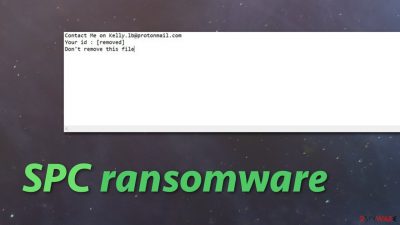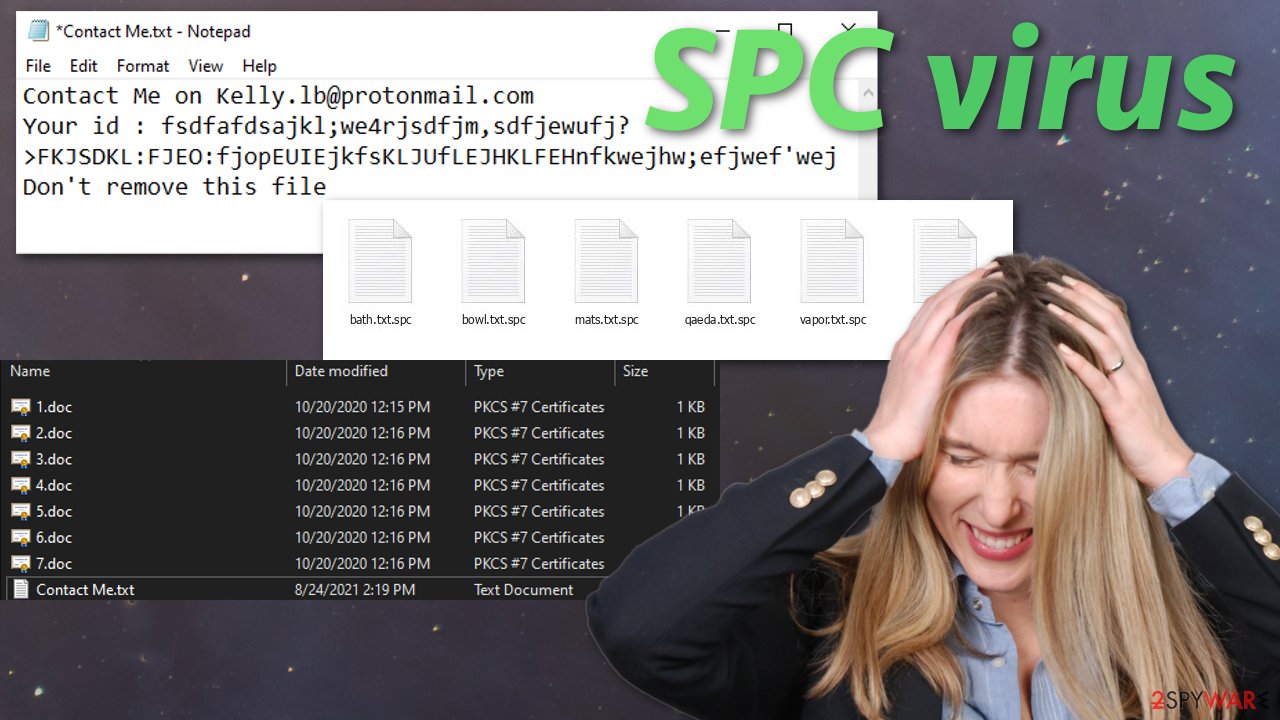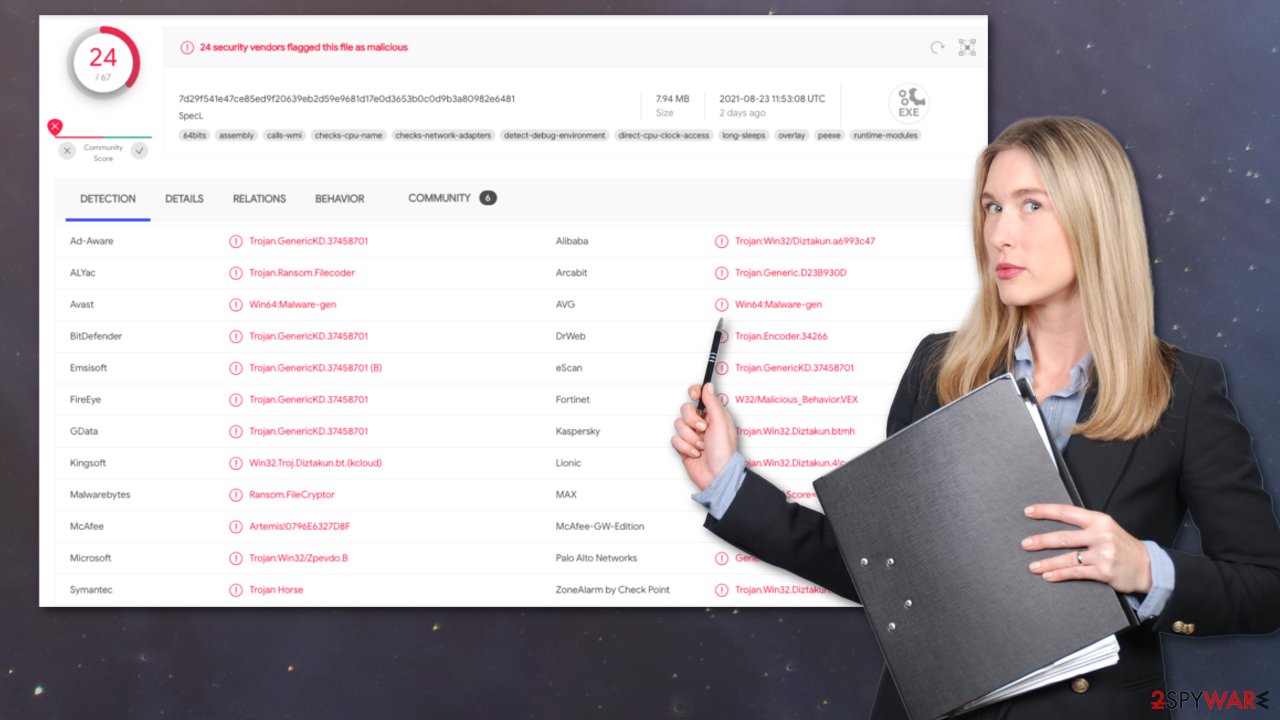SPC ransomware (virus) - Recovery Instructions Included
SPC virus Removal Guide
What is SPC ransomware?
SPC ransomware encrypts files on your PC, so you cannot access them

Ransomware is one of the most extreme computer viruses because it uses extortion and blackmail tactics to get money from the victims. Big corporations might be threatened to get their information posted on the internet if they do not pay up, and private individuals can spend all their savings to get their data because they did not back it up. This makes ransomware development a lucrative business as it can cause a lot of damage which the targets want to avoid by paying money.
SPC is a malicious program that infects users through infected email attachments, malicious ads, or torrent websites.[1] It encrypts victims' photos, videos, documents, and other data so the files could not be opened. It appends the .spc extension to every affected file, and the icons get changed to blank pages. For example, if the file's name was picture.jpg, after encryption, it looks like this – picture.jpg.spc.
A unique decryption key[2] is generated soon after the encryption is done, which only the hacker has. A ransom note is then created to inform the victim of what has happened. The note from SPC ransomware developers is shorter than usual. It includes only the contact email of the attackers – Kelly.lb@protonmail.com and the ID assigned to the victim.
It seems that cybercriminals want to keep the details between them and the victims because the ransom amount and how it should be paid is not disclosed initially. It is not recommended to contact the attackers or even pay them. Many victims of ransomware attacks report that after paying the hackers, they never heard back from them, so they got scammed as well. If you pay the threat actors, you risk losing not only your files but your money too.
| NAME | SPC |
| TYPE | Ransomware, file locker, cryptovirus |
| DISTRIBUTION | Infected email attachments, torrent websites, malicious ads |
| FILE EXTENSION | .spc |
| RANSOM NOTE | Contact Me.txt |
| ENCRYPTION METHOD | AES + RSA |
| FILE RECOVERY | If you do not have backups, the only way to decrypt the files is by getting the key that only the hackers have. There are additional recovery options using third-party software that we cover in this article |
| MALWARE REMOVAL | The malicious program should only be removed with SpyHunter 5Combo Cleaner to ensure all the files are gone. Keep in mind that the antivirus cannot recover your data |
| SYSTEM FIX | FortectIntego maintenance tool can fix damaged files and other system errors to help victims avoid having to reinstall the operating system completely |
Usually, the only way to unlock the files is to get a decryption key. The problem is that decryption keys are not always retrieved from hackers, so the only option left is to try using third-party software created for that purpose. If users have not backed up their data on an external source, that is their only chance. Data recovery software does not always work, so people have to be prepared that they possibly lost their files forever.
Also, ransomware can cause even more damage by infecting other devices on the same network. The first thing a person should do is disconnect from the internet. Please do not use the local network and choose one that does not have any other devices connected to it.
Along with contact details in the ransom note, users are warned not to delete it. The full message says:
Contact Me on Kelly.lb@protonmail.com
Your id: –
Don't remove this file
It is unclear why the attackers instruct the victims not to remove the note as it is just a simple text document. It is probably another scare tactic used to inflict fear and make people more likely to do what they say.

Distribution methods
It is unknown how this particular virus infiltrates the machine, but generally, ransomware is distributed through email, malicious ads, that upon clicking on them, starts the download automatically. The next biggest threats are installations of “cracked” software or “cracking” tools themselves. As this activity is illegal, the programs are distributed on unregulated third-party websites. Malicious programs come attached as a bundle. If users do not spot them during the installation process, they successfully infiltrate the machine and perform unwanted tasks.
How to avoid virus infections?
There are several steps you can take to prevent ransomware infection. The implementation of security practices should significantly reduce your chances of going through this again. Following them improves your defenses from all sorts of attacks:
- Keep your operating system and other programs patched and up-to-date to ensure that you do not have vulnerabilities that threat actors could exploit.
- Do not install software or give it administrative privileges unless you know exactly what it is.
- Have professional and trusted antivirus software installed, detecting malicious programs like ransomware as they arrive and warn you about it.
- Keep back-ups of all your files either on a cloud service or on an external device like a USB or hard drive. This will not stop an attack, but it will make the damage caused by one less significant.
- Do not download software from unofficial sources. We know that it can get quite costly, but you are vulnerable and more likely to get infected by looking for free options. You could also get caught and have to pay a fine[3] which will be much bigger than the price you would have paid for the program. By downloading freeware, you also will not receive updates, which can limit the app's functionality.
- Do not blindly download email attachments as they can be infected. Always make sure the attachment was expected. Emails coming from unknown senders containing grammar or spelling mistakes or not, asking you to download an attachment you had no idea about, should not be opened and deleted immediately.

Remove the intruder from your machine
The first thing you have to do is remove the malicious files that are executing the tasks. If you try to recover the files without eliminating the cause, it can encrypt your files again and result in more damage. Removing the virus yourself should not be an option unless you have experience in this and know what you are doing. Use anti-malware tools like SpyHunter 5Combo Cleaner or Malwarebytes to scan your system. This security software should find all the related files and entries and remove them automatically for you. Automatic removal is the best option because there is less risk of leaving some of the files on our system. Another thing to note is the malicious program could be preventing you from using the antivirus software, so check that first.
If you are unable to do it, proceed with accessing Safe Mode on Windows:
Windows 7 / Vista / XP
- Click Start > Shutdown > Restart > OK.
- When your computer becomes active, start pressing F8 button (if that does not work, try F2, F12, Del, etc. – it all depends on your motherboard model) multiple times until you see the Advanced Boot Options window.
- Select Safe Mode with Networking from the list.
![Windows XP/7 Windows XP/7]()
Windows 10 / Windows 8
- Right-click on Start button and select Settings.
- Scroll down to pick Update & Security.
![Update & Security Update & Security]()
- On the left side of the window, pick Recovery.
- Now scroll down to find Advanced Startup section.
- Click Restart now.
![Recovery Recovery]()
- Select Troubleshoot.
![Choose an option Choose an option]()
- Go to Advanced options.
![Advanced options Advanced options]()
- Select Startup Settings.
![Startup settings Startup settings]()
- Click Restart.
- Press 5 or click 5) Enable Safe Mode with Networking.
![Press F5 to enable Safe Mode with Networking Press F5 to enable Safe Mode with Networking]()
Data recovery options
Only hackers hold the decryption key, which can unlock your files, so if you did not back them up previously, you possibly lost your files forever. You can try using data recovery software, but third-party programs cannot always decrypt the files. We suggest at least trying it because it cannot hurt.
Important – only do this if you have already removed SPC ransomware
Before proceeding, you must copy the corrupted files and place them in a USB flash drive or another external storage. In case something happens, you will at least still have the encrypted files.
- Download Data Recovery Pro.
- Double-click the installer to launch it.
![SPC ransomware SPC ransomware]()
- Follow on-screen instructions to install the software.
![Install program Install program]()
- As soon as you press Finish, you can use the app.
- Select Everything or pick individual folders where you want the files to be recovered from.
![Select what to recover Select what to recover]()
- Press Next.
- At the bottom, enable Deep scan and pick which Disks you want to be scanned.
![Select Deep scan Select Deep scan]()
- Press Scan and wait till it is complete.
![Scan Scan]()
- You can now pick which folders/files to recover – don't forget you also have the option to search by the file name!
- Press Recover to retrieve your files.
![Recover files Recover files]()
Avoid having to reinstall the operating system
Performance, stability, and usability issues, to the point where a full Windows reinstall is required, are expected after malware infection. These types of infections can alter the Windows registry database, damage vital bootup and other sections, delete or corrupt DLL files, etc. Once a system file is damaged by malware, antivirus software is not able to repair it.
There are tools created just for this purpose. FortectIntego can fix a lot of the damage caused by an infection like this. Blue Screen errors, freezes, registry errors, damaged DLLs, etc., can make your computer completely unusable. By using this maintenance tool, you could try fixing the damaged system and avoid reinstallation.
- Download the application by clicking on the link above
- Click on the ReimageRepair.exe
![Reimage download Reimage download]()
- If User Account Control (UAC) shows up, select Yes
- Press Install and wait till the program finishes the installation process
![Reimage installation Reimage installation]()
- The analysis of your machine will begin immediately
![Reimage scan Reimage scan]()
- Once complete, check the results – they will be listed in the Summary
- You can now click on each of the issues and fix them manually
- If you see many problems that you find difficult to fix, we recommend you purchase the license and fix them automatically.
![Reimage results Reimage results]()
Additional tips for victims in the corporate environment
Some ransomware strains aim to infect not only one computer but hijack the entire network. As soon as one of the machines is infected, malware can spread via network and encrypt files everywhere else, including Network Attached Storage (NAS) devices. If your computer is connected to a network, it is important to isolate it to prevent re-infection after ransomware removal is complete.
The easiest way to disconnect a PC from everything is simply to plug out the ethernet cable. However, in the corporate environment, this might be extremely difficult to do (also would take a long time). The method below will disconnect from all the networks, including local and the internet, isolating each machine involved.
- Type in Control Panel in Windows search and press Enter
- Go to Network and Internet
![Network and internet Network and internet]()
- Click Network and Sharing Center
![Network and internet 2 Network and internet 2]()
- On the left, pick Change adapter settings
![Network and internet 3 Network and internet 3]()
- Right-click on your connection (for example, Ethernet), and select Disable
![Network and internet 4 Network and internet 4]()
- Confirm with Yes.
If you are using some type of cloud storage you are connected to, you should disconnect from it immediately. It is also advisable to disconnect all the external devices, such as USB flash sticks, external HDDs, etc. Once the malware elimination process is finished, you can connect your computers to the network and internet, as explained above, but by pressing Enable instead.
Report attacks to have a better chance at catching the cybercriminals
- USA – Internet Crime Complaint Center IC3
- United Kingdom – ActionFraud
- Canada – Canadian Anti-Fraud Centre
- Australia – ScamWatch
- New Zealand – ConsumerProtection
- Germany – Polizei
- France – Ministère de l'Intérieur
If your country is not listed above, you should contact the local police department or communications center.
How to prevent from getting ransomware
Stream videos without limitations, no matter where you are
There are multiple parties that could find out almost anything about you by checking your online activity. While this is highly unlikely, advertisers and tech companies are constantly tracking you online. The first step to privacy should be a secure browser that focuses on tracker reduction to a minimum.
Even if you employ a secure browser, you will not be able to access websites that are restricted due to local government laws or other reasons. In other words, you may not be able to stream Disney+ or US-based Netflix in some countries. To bypass these restrictions, you can employ a powerful Private Internet Access VPN, which provides dedicated servers for torrenting and streaming, not slowing you down in the process.
Data backups are important – recover your lost files
Ransomware is one of the biggest threats to personal data. Once it is executed on a machine, it launches a sophisticated encryption algorithm that locks all your files, although it does not destroy them. The most common misconception is that anti-malware software can return files to their previous states. This is not true, however, and data remains locked after the malicious payload is deleted.
While regular data backups are the only secure method to recover your files after a ransomware attack, tools such as Data Recovery Pro can also be effective and restore at least some of your lost data.
- ^ Charlie Osborne. Torrent websites infect 12 million users a month with malware. ZDNet. Security News.
- ^ Decryption key. ManagementMania. Definitions.
- ^ Devin Partida. Why You Shouldn't Use Pirated Software (But Why People Still Do). Computer. Tech News.





















